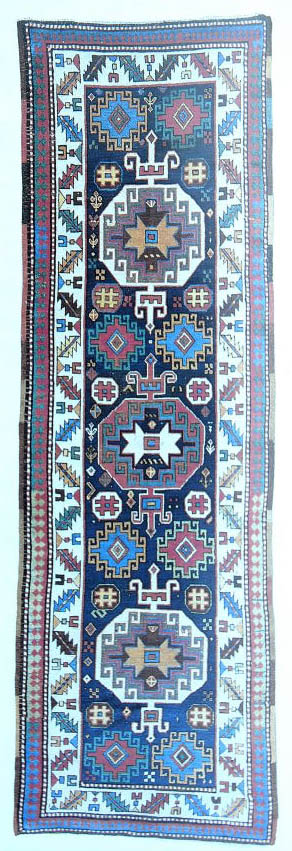Here are a few pieces culled from a previously
published periodical, the Oriental Rug Review. They are mostly described
as Shahsavan and are all pile weavings.
The first one is from Volume
15, Number 3, February/March 1995:

There was no comment in the magazine
regarding this rug other than the Shahsavan attribution. It was sold at a
Rippon Boswell auction which is infamous for being a turning point in
oriental rug auctions when Eberhart Herrmann bought a large number of rugs
at very high prices.
The next pair was published in June/July 1988. A
close up of one of these bag faces is on the cover:
http://www.rugreview.com/bi85.htm
A very brief comment accompanied
these pieces:
"A set of pile Shahsavan donkeybag faces has been
photographed to show dark (top) and light (bottom) color aspects of rugs.
The top piece was woven first and the pile inclines to the top side. The
pile in the other piece inclines to the bottom side. This light and dark
effect is the result of the way light strikes the inclination of the
pile.
The magenta red used exclusively in the main border is a color
generally believed to be derived from a cochineal source."
There is a
technical analysis of these pieces:
Warp:Ivory wool, z2s, no
depression
Weft: Top, red wool; bottom, red, brown, and tan
wool;
Knot: Symmetric, horizontal 8 and 9, vertical 12 to 14, 96 to 126
per square inch, pile 1/2"
Colors: Ivory, magenta, red, rust, dark
blue, mid blue, green. gold, yellow, natural brown (camel?) and, in
bottom, dark blue-green and faded lavender (fuchsine?)
This description
appears consistent with the features of Shahsavan weavings postulated by
Wendel Swan.
Next is a striking piece shown in an advertisement from
Peter Willborg from the June/July 1991 ORR.

The only comment is "Shahsavan, early 20th
Century." It has an enlarged version of the "flower and bud" design
described by Tanavoli in Shahsavan and many other features common to
Shahsavan weaving, including what appears to be a camel wool field,
people, animals and more. Mr. Willborg would be considered quite competent
to differentiate Shahsavan weavings from other NW Persian
pieces.
Finally, here is a piece from the December/January 1995 ORR
described by Carl Strock:
"And speaking of Shahsavan shield devices,
Christie's sold a rather dramatic Kazak rug bearing six of
these..."

It is
described as Kazak, although no reason for not assigning it a Shahsavan
attribution is given other than Christie's auction house designated it as
Kazak.
These pieces were sold before the Tanavoli article in Hali and
show that a tentative attribution to Shahsavan weavers of pile pieces was
already commonly used.
Patrick Weiler